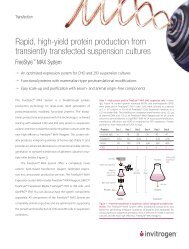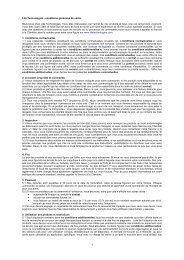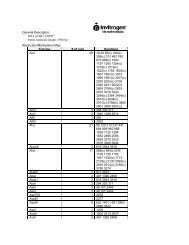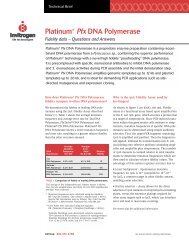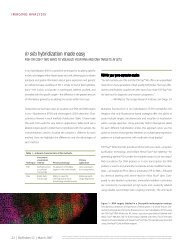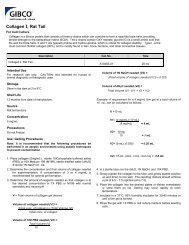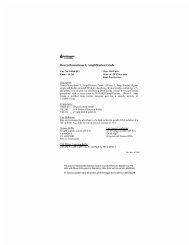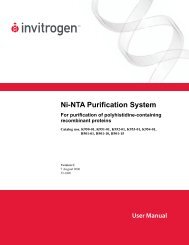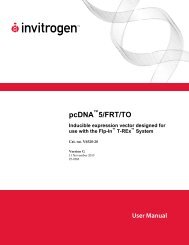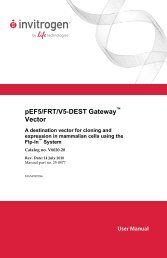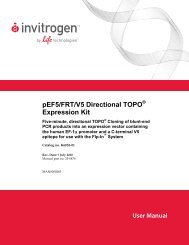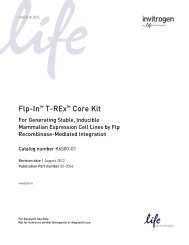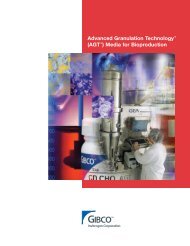Analysis of FP Binding Data - Invitrogen
Analysis of FP Binding Data - Invitrogen
Analysis of FP Binding Data - Invitrogen
You also want an ePaper? Increase the reach of your titles
YUMPU automatically turns print PDFs into web optimized ePapers that Google loves.
CHAPTER 8<br />
<strong>Analysis</strong> <strong>of</strong> <strong>FP</strong> <strong>Binding</strong> <strong>Data</strong><br />
Determination <strong>of</strong> <strong>Binding</strong> Constants . . . . . . . . . . . . . . . . . . . . . . . . . . . . . . . . . . . . . . . . . . . . . . . . . . . . . . . . . . . . . . . . . . . . . . . . . . . . . . 8-2<br />
Definitions . . . . . . . . . . . . . . . . . . . . . . . . . . . . . . . . . . . . . . . . . . . . . . . . . . . . . . . . . . . . . . . . . . . . . . . . . . . . . . . . . . . . . . . . . . . . . . . . . . . . . . . . . . . . . . . 8-2<br />
Polarization vs. Anisotropy . . . . . . . . . . . . . . . . . . . . . . . . . . . . . . . . . . . . . . . . . . . . . . . . . . . . . . . . . . . . . . . . . . . . . . . . . . . . . . . . . . . . . . . . . . . . . . . . 8-2<br />
Relationship <strong>of</strong> Anisotropy to Bound/Free Ratio . . . . . . . . . . . . . . . . . . . . . . . . . . . . . . . . . . . . . . . . . . . . . . . . . . . . . . . . . . . . . . . . . . . . . . . . . . . 8-3<br />
Changes in Fluorescence Intensity and Fluorescence Lifetime . . . . . . . . . . . . . . . . . . . . . . . . . . . . . . . . . . . . . . . . . . . . . . . . . . . . . . . . . . . . . 8-4<br />
Seeing a Signal . . . . . . . . . . . . . . . . . . . . . . . . . . . . . . . . . . . . . . . . . . . . . . . . . . . . . . . . . . . . . . . . . . . . . . . . . . . . . . . . . . . . . . . . . . . . . . . . . . . . . . . . . . . 8-4<br />
Equilibrium <strong>Binding</strong>: Experimental Design . . . . . . . . . . . . . . . . . . . . . . . . . . . . . . . . . . . . . . . . . . . . . . . . . . . . . . . . . . . . . . . . . . . . . . . . . . . . . . . . 8-6<br />
Incubation Time to Reach Equilibrium . . . . . . . . . . . . . . . . . . . . . . . . . . . . . . . . . . . . . . . . . . . . . . . . . . . . . . . . . . . . . . . . . . . . . . . . . . . . . . . . . . . . 8-6<br />
Constructing a <strong>Binding</strong> Isotherm . . . . . . . . . . . . . . . . . . . . . . . . . . . . . . . . . . . . . . . . . . . . . . . . . . . . . . . . . . . . . . . . . . . . . . . . . . . . . . . . . . . . . . . . . 8-6<br />
<strong>Analysis</strong> <strong>of</strong> <strong>Binding</strong> Constants . . . . . . . . . . . . . . . . . . . . . . . . . . . . . . . . . . . . . . . . . . . . . . . . . . . . . . . . . . . . . . . . . . . . . . . . . . . . . . . . . . . . . . . . . . . . 8-7<br />
Competition Experiments . . . . . . . . . . . . . . . . . . . . . . . . . . . . . . . . . . . . . . . . . . . . . . . . . . . . . . . . . . . . . . . . . . . . . . . . . . . . . . . . . . . . . . . 8-10<br />
General Considerations . . . . . . . . . . . . . . . . . . . . . . . . . . . . . . . . . . . . . . . . . . . . . . . . . . . . . . . . . . . . . . . . . . . . . . . . . . . . . . . . . . . . . . . . . . . . . . . . . . 8-10<br />
Receptor-Ligand Competition Experiments . . . . . . . . . . . . . . . . . . . . . . . . . . . . . . . . . . . . . . . . . . . . . . . . . . . . . . . . . . . . . . . . . . . . . . . . . . . . . . 8-10<br />
Kinetic Experiments . . . . . . . . . . . . . . . . . . . . . . . . . . . . . . . . . . . . . . . . . . . . . . . . . . . . . . . . . . . . . . . . . . . . . . . . . . . . . . . . . . . . . . . . . . . . . 8-11<br />
Determination <strong>of</strong> the Dissociation Rate Constant, k –1 . . . . . . . . . . . . . . . . . . . . . . . . . . . . . . . . . . . . . . . . . . . . . . . . . . . . . . . . . . . . . . . . . . . . . 8-11<br />
Determination <strong>of</strong> the Association Rate Constant, k 1 . . . . . . . . . . . . . . . . . . . . . . . . . . . . . . . . . . . . . . . . . . . . . . . . . . . . . . . . . . . . . . . . . . . . . . . 8-12
2 • Fluorescence Polarization Technical Resource Guide • <strong>Analysis</strong> <strong>of</strong> <strong>FP</strong> <strong>Binding</strong> <strong>Data</strong><br />
• Weber, G. (1952) Biochem. 51:145-55.<br />
Determination <strong>of</strong> <strong>Binding</strong> Constants<br />
Definitions<br />
“Receptor” and “ligand” have traditionally been used to describe large, membrane-bound receptors<br />
and small, soluble ligands, respectively. In fact, the terms are interchangeable when discussing any two<br />
molecules that bind to each other; the analysis <strong>of</strong> binding data does not draw a distinction between<br />
the two terms. In most traditional binding experiments, the receptor concentration is kept constant<br />
and the ligand concentration is varied. It is equally correct to keep the ligand concentration constant<br />
and vary the receptor concentration. In <strong>FP</strong>, on the other hand, it is the small, labeled ligand that is held<br />
constant at low concentrations and a much larger, unlabeled molecule is titrated against it. The experi-<br />
ments are done this way in order to vary the labeled ligand from the completely free state (and lowest<br />
polarization value) to the completely bound state (and highest polarization value, thus maximizing the<br />
dynamic range <strong>of</strong> the experiment. The role <strong>of</strong> the receptor and ligand in <strong>FP</strong> experiments is opposite<br />
that <strong>of</strong> traditional radioligand experiments (where [receptor] is held constant and [ligand] varies). The<br />
scientist using fluorescence polarization must, therefore, decide whether to use the classic equations<br />
as written and hope to remember that receptor really means ligand (and vice versa), or instead rewrite<br />
those equations for experiments using fluorescence polarization.<br />
In past editions <strong>of</strong> this Guide, we had chosen the former route—to the endless confusion <strong>of</strong> our readers. In<br />
this edition, we have taken then second route, rederiving these equations specifically for <strong>FP</strong>-based applica-<br />
tions. We still retain the intuitive phrases “ligand” to refer to the small, labeled molecule, and “receptor” for<br />
the much larger, unlabeled molecule.<br />
Polarization vs. Anisotropy<br />
Polarization and anisotropy are both derived from the measured vertical and horizontal intensities (see<br />
Chapter 1). The values are mathematically related and easily interconverted. Both values represent a<br />
weighted average <strong>of</strong> the bound vs. unbound states <strong>of</strong> the fluorescent molecule. If most <strong>of</strong> the ligand is<br />
unbound, the polarization/anisotropy value will be low. As the fraction <strong>of</strong> labeled molecules that is bound<br />
increases, the polarization/anisotropy value increases to a maximum value that corresponds to the fluores-<br />
cent molecule being 100% bound.<br />
A population <strong>of</strong> excited, identical molecules in solution all have the same polarization value. If a portion <strong>of</strong> these<br />
molecules undergo an apparent size change such that their rotational relaxation rate also changes, the observed<br />
polarization value represents an average <strong>of</strong> the component polarizations <strong>of</strong> all <strong>of</strong> the molecules. The polarization<br />
<strong>of</strong> a mixture <strong>of</strong> molecules is given by Weber (1952):<br />
Equation 8.1:<br />
where each fluorophore species has a polarization P i and fractional fluorescence intensity f i. On the<br />
other hand, the additivity <strong>of</strong> anisotropies is given by a simpler equation:<br />
<strong>Invitrogen</strong> Corporation • 501 Charmany Drive • Madison, WI 53719 • USA • www.invitrogen.com/drugdiscovery<br />
n<br />
1 1<br />
- =∑<br />
P 3<br />
-1 -1<br />
i = 1<br />
f i Pi<br />
1 1<br />
-<br />
3<br />
n<br />
Equation 8.2: A = ∑ (fi )(Ai )<br />
i = 1
<strong>Analysis</strong> <strong>of</strong> <strong>FP</strong> <strong>Binding</strong> <strong>Data</strong> • Fluorescence Polarization Technical Resource Guide • 3<br />
Due to mathematical simplicity, anisotropy values are preferred because it is easier to deconvolute<br />
anisotropy values into their component values than it is polarization values. It should be noted again<br />
that in the majority <strong>of</strong> applications, anisotropy does not give any additional information than polariza-<br />
tion.<br />
As shown in Table 8-1, polarization values can be manipulated as if they were anisotropy values (i.e.,<br />
combined by simple additivity); the resultant errors are in the range <strong>of</strong> less than 1% to 2.5% when<br />
polarization values reach 250 mP.<br />
Table 8-1. The polarization value <strong>of</strong> a hypothetical mixture was calculated using Equation 8.1 by treating the polarization values<br />
as though they were anisotropies (simply additive).<br />
Example 1<br />
Free Ligand 50 mP 80%<br />
Bound Ligand 150 mP 20%<br />
Example 2<br />
Free Ligand 50 mP 60%<br />
Bound Ligand 250 mP 40%<br />
Since most instruments calculate both polarization and anisotropy, there is little reason to use<br />
polarization in your analysis. If your instrument does not report anisotropy values, the two are easily<br />
interconverted:<br />
We generally use the term “Fluorescence Polarization” instead <strong>of</strong> “Fluorescence Anisotropy” because<br />
<strong>FP</strong> is most <strong>of</strong>ten the term used to describe the entire technology. In many applications that involve a<br />
minimum <strong>of</strong> curve analysis, we still use polarization.<br />
Relationship <strong>of</strong> Anisotropy to Bound/Free Ratio<br />
Fluorescent molecules involved in binding events (e.g., ligand-receptor interactions) will exist in only<br />
one <strong>of</strong> two states: bound or free. In the general case, the bound and free states <strong>of</strong> the fluorescent<br />
ligand will each have a unique anisotropy value—high for the bound state and low for the free state<br />
(quenching caused by binding complicates the analysis). With only two species, the anisotropy additiv-<br />
ity equation reduces to:<br />
where: F f + F b = 1<br />
A = observed anisotropy value<br />
Equation 8.3: A =<br />
F f = fraction <strong>of</strong> fluorescent ligand that is free<br />
F b = fraction <strong>of</strong> fluorescent ligand that is bound<br />
A f = anisotropy <strong>of</strong> the free fluorescent ligand<br />
A b = anisotropy <strong>of</strong> the bound fluorescent ligand<br />
Fraction Using Equation 8.3 Using Simple Additivity Error<br />
2 × P<br />
3 - P<br />
Equation 8.4: A = F fA f + F bA b<br />
71 mP 70 mP
• Fluorescence Polarization Technical Resource Guide • <strong>Analysis</strong> <strong>of</strong> <strong>FP</strong> <strong>Binding</strong> <strong>Data</strong><br />
The top and bottom plateaus <strong>of</strong> the semi-log equilibrium binding isotherm (anisotropy vs. log total<br />
receptor concentration) define the anisotropy <strong>of</strong> the free and bound states, A f and A b. With the observed<br />
anisotropy, A, we can calculate the fraction <strong>of</strong> bound and free fluorescent ligand for a given anisotropy<br />
value. For instance, if the A free = 60 mA (mA = millianisotropy units) and A bound = 160 mA, at a mA = 110, half<br />
<strong>of</strong> the fluorescent ligands will be bound and half will be free. At A = 135 mA, 75% <strong>of</strong> the fluorescent ligands<br />
will be bound. This linearity <strong>of</strong> response means that anisotropy values can be equated directly to ‘fraction<br />
bound,’ though it may be more prudent to convert anisotropy values to bound ligand concentration. This<br />
is especially true for the proper analysis <strong>of</strong> direct equilibrium binding experiments, when the value <strong>of</strong><br />
bound ligand is required to calculate the concentration <strong>of</strong> bound and free unlabeled receptor.<br />
Changes in Fluorescence Intensity and Fluorescence Lifetime<br />
The simple use <strong>of</strong> polarization or anisotropy data is predicated on the quantum yield <strong>of</strong> the fluorophore<br />
being the same in the bound (Q b) and free (Q f) state. Changes in quantum yield <strong>of</strong> the fluor is usually<br />
not a problem unless the fluor is directly involved in the binding event, for instance, with the binding<br />
<strong>of</strong> fluorescein by a anti-fluorescein antibody. Chapter 3 describes the mathematical corrections neces-<br />
sary when quenching occurs.<br />
Seeing a Signal<br />
In order to see a change in polarization, the concentrations <strong>of</strong> ligand and receptor concentrations must<br />
be chosen so that at low receptor concentrations, the ligand remains unbound (low polarization value),<br />
and at high receptor concentrations, the ligand is primarily bound (high polarization value). Careful choice<br />
<strong>of</strong> the experimental concentrations will maximize the difference between the highest and lowest polar-<br />
ization values and therefore increase the sensitivity <strong>of</strong> the assay.<br />
Solving the general Equation 7.2 for B (receptor:ligand complex) in terms <strong>of</strong> R T and L T yielded Equation<br />
7.8, presented in this chapter as Equation 8.5:<br />
Equation 8.5: B =<br />
Notice that Equation 8.5 is perfectly symmetrical with respect to R and L, as stated at the beginning<br />
<strong>of</strong> this chapter. That is, R T and L T are interchangeable. Experimentally, either the ligand or receptor can<br />
be held constant and the other varied.<br />
The explicit solution <strong>of</strong> B in terms <strong>of</strong> R T and L T, and the obvious interexchangeability <strong>of</strong> R T and L T is a striking<br />
demonstration that the analysis <strong>of</strong> <strong>FP</strong> data is completely analogous to the analysis <strong>of</strong> classical radioligand<br />
binding experiments. The implications <strong>of</strong> Equation 8.5 with regards to the percentage <strong>of</strong> ligand and recep-<br />
tor bound at different concentrations are shown in Table 8-2.<br />
<strong>Invitrogen</strong> Corporation • 501 Charmany Drive • Madison, WI 53719 • USA • www.invitrogen.com/drugdiscovery<br />
LT + Kd + RT - [(LT + Kd + RT )<br />
2<br />
2 - 4LTRT ]
Table 8-2. Range <strong>of</strong> percentages <strong>of</strong> ligand and receptor bound under typical experimental conditions.<br />
Ligand Concentration<br />
([L]/K d)<br />
0.01<br />
0.1<br />
<strong>Analysis</strong> <strong>of</strong> <strong>FP</strong> <strong>Binding</strong> <strong>Data</strong> • Fluorescence Polarization Technical Resource Guide • 5<br />
We would normally design <strong>FP</strong> binding experiments so that the labeled ligand concentration would<br />
be kept well below the K d ([L]/K d < 0.1). As receptor is titrated against ligand, the percentage <strong>of</strong> ligand<br />
bound varies across a wide percentage (i.e., large signal dynamic range). Simultaneously, very little<br />
receptor is bound, thus avoiding a situation <strong>of</strong> “receptor depletion” (analogous to the “ligand depletion”<br />
described in Chapter 7).<br />
1<br />
10<br />
Receptor Concentration<br />
([L]/K d)<br />
If the <strong>FP</strong> experiment is run at a higher constant ligand concentration, as occurs in many cases, the per-<br />
cent <strong>of</strong> the ligand bound versus receptor concentration still covers an adequate range, but significant<br />
amounts <strong>of</strong> receptor are also bound (“receptor depletion”). In this case, the simplified binding equa-<br />
tions, which assume only a tiny fraction <strong>of</strong> receptor is bound, cannot be used. The explicit equations<br />
must be used instead. The determination <strong>of</strong> K d and the solution <strong>of</strong> binding equations must be dealt<br />
with mathematically as described in Chapter 7 and later in Chapter 8. In the case <strong>of</strong> direct binding and<br />
competition experiments, unless the correct mathematical treatment is applied, the observed EC 50 or<br />
IC 50, respectively, will be overestimations <strong>of</strong> the true K d and K I.<br />
It is fortuitous that in <strong>FP</strong> competition experiments, since the receptor concentrations must be neces-<br />
sarily high to bind significant fluorescent ligand (the maximizing the polarization value), the “receptor<br />
depletion” effect is reduced (e.g., [ligand] = 1 × K d and [receptor] = 10 × K d, so that 90% <strong>of</strong> the ligand is<br />
bound, but only 9% <strong>of</strong> the receptor; Table 8-2).<br />
% Ligand Bound<br />
at Equilibrium<br />
% Receptor Bound<br />
at Equilibrium<br />
0.01 1 1.0<br />
0.1 9 0.5<br />
1 50 0.1<br />
10 91 0.09<br />
50 98 0.02<br />
0.01 0.9 9.0<br />
0.1 8.4 8.4<br />
1 49 4.9<br />
10 91 0.9<br />
50 98 0.2<br />
0.01 0.1 50<br />
0.1 5.0 49<br />
1 38 38<br />
10 90 9.0<br />
50 98 2.0<br />
0.01 0.1 91<br />
0.1 0.9 90.8<br />
1 9 90.1<br />
10 73 73<br />
50 98 19.5<br />
Phone: 800 955 6288 • Fax: 760 602 6500 • E-mail: tech_service@invitrogen.com
6 • Fluorescence Polarization Technical Resource Guide • <strong>Analysis</strong> <strong>of</strong> <strong>FP</strong> <strong>Binding</strong> <strong>Data</strong><br />
Equilibrium <strong>Binding</strong>: Experimental Design<br />
Incubation Time to Reach Equilibrium<br />
Before a classic receptor/ligand equilibrium binding experiment can be completed, the incubation<br />
period required for equilibrium to be achieved must be empirically determined. Time to reach equilib-<br />
rium is dependent on the concentrations <strong>of</strong> the ligand and receptor, so the worst case concentrations<br />
should be used, namely, the chosen constant labeled ligand concentration and the lowest receptor<br />
concentration envisioned.<br />
Step 1. Determination <strong>of</strong> Equilibrium Time using the Beacon® 2000 System<br />
1. Background blank the buffer.<br />
2. Add the ligand to the tube and take several readings to determine the polarization <strong>of</strong> free<br />
ligand.<br />
3. To the same tube, add an amount <strong>of</strong> receptor approximately equal to 1/20 <strong>of</strong> the expected K d.<br />
<strong>Invitrogen</strong> Corporation • 501 Charmany Drive • Madison, WI 53719 • USA • www.invitrogen.com/drugdiscovery<br />
Because the rate <strong>of</strong> association is dependent on the receptor concentration, this combination<br />
<strong>of</strong> low ligand and receptor concentrations represents the longest time necessary to reach<br />
equilibrium.<br />
4. Follow the increase in polarization over time (begin with 10 minute intervals). Determine the<br />
time at which the polarization values plateau, representing the approach to equilibrium. Use<br />
this time for the incubation period <strong>of</strong> the binding experiments outlined later.<br />
Constructing a <strong>Binding</strong> Isotherm<br />
As described earlier, the format <strong>of</strong> the typical equilibrium <strong>FP</strong> binding experiment involves incubating<br />
a sub-K d concentration <strong>of</strong> labeled ligand with a wide range <strong>of</strong> receptor concentrations from below to<br />
above the anticipated K d. In those cases when there is no prior information about the K d, it is not disas-<br />
trous to incorrectly choose these concentrations; it will become apparent when the data are inspected<br />
if the experiment should be repeated with a different range <strong>of</strong> receptor concentrations.
Step 2. Construction <strong>of</strong> a <strong>Binding</strong> Isotherm Using the Beacon® 2000 Analyzer<br />
<strong>Analysis</strong> <strong>of</strong> <strong>FP</strong> <strong>Binding</strong> <strong>Data</strong> • Fluorescence Polarization Technical Resource Guide • 7<br />
1. Serially dilute your unlabeled receptor into approximately 20 test tubes, covering the range<br />
<strong>of</strong> concentrations from 10- to 20-fold below the K d to approximately 50- to 100-fold above<br />
the K d. The final volumes should be at least 0.1 mL.<br />
2. If the background fluorescence <strong>of</strong> the tube with the highest concentration <strong>of</strong> receptor is very<br />
low, there is no need to account for the background fluorescence. The background contributed<br />
by some samples (e.g., from impure protein or antibody preparations) can be high and must be<br />
taken into account. There are two suggested correction methods:<br />
a. If polarization values will be determined only once, a single set <strong>of</strong> tubes is sufficient (as<br />
described above). Measure and record the background intensity <strong>of</strong> each tube with the<br />
Beacon® 2000 Fluorescence Polarization System in its batch mode and then continue on<br />
to Step 3.<br />
b. In some experiments, it may be useful to determine polarization values several times,<br />
for instance, after incubations at different temperatures. Background fluorescence<br />
values need to be determined each time the samples are reread. If the labeled ligand<br />
has already been added to the tubes, measurement <strong>of</strong> background fluorescence is<br />
impossible. In these cases, prepare a duplicate set <strong>of</strong> tubes that will not receive the<br />
fluorescent ligand.<br />
3. Add identical aliquots <strong>of</strong> the ligand to each tube and mix.<br />
4. Incubate the tubes for the time determined in Step 1.<br />
5. Measure the polarization value <strong>of</strong> each tube. Because the Beacon® 2000 Fluorescence<br />
Polarization System is being used in the batch mode, it is important that determinations are<br />
made in the same order as blank readings were taken.<br />
<strong>Analysis</strong> <strong>of</strong> <strong>Binding</strong> Constants<br />
Upon completion <strong>of</strong> the binding experiment, the measured data will be millipolarization (or millianisotropy)<br />
units vs. total receptor concentration. Much was said in the previous chapter about analysis<br />
<strong>of</strong> binding curves. In this Section, we will limit our discussion to only the practical considerations <strong>of</strong><br />
analysis <strong>of</strong> these data.<br />
Step 3. Convert to Anisotropy<br />
If you didn’t already record your data as anisotropy, now is the time to convert the polarization values.<br />
Either acquire the anisotropy data from your downloaded Beacon® 2000 Fluorescence Polarization<br />
System spreadsheet or convert your polarization values to anisotropy.<br />
Step 4. Receptor Depletion?<br />
Before choosing the equations to use for analysis, it is important to know whether receptor depletion<br />
is a problem. That is, is a significant percentage <strong>of</strong> the receptor is bound such that the total receptor<br />
concentration cannot be used as a good approximation <strong>of</strong> the free receptor concentration. In determining<br />
if there is a problem, the mA values must first be converted into bound ligand concentrations<br />
using the following equation:<br />
Phone: 800 955 6288 • Fax: 760 602 6500 • E-mail: tech_service@invitrogen.com
8 • Fluorescence Polarization Technical Resource Guide • <strong>Analysis</strong> <strong>of</strong> <strong>FP</strong> <strong>Binding</strong> <strong>Data</strong><br />
where:<br />
Equation 8.6: [Ligand Bound] = L T × = B<br />
A - A f<br />
A b - A f<br />
LT = the total added concentration <strong>of</strong> ligand<br />
A = the experimental anisotropy<br />
Af = the anisotropy for the free ligand<br />
Ab = the anisotropy for the fully bound ligand<br />
The quotient is termed Fb and is equal to the fraction <strong>of</strong> ligand bound. For this application, the values<br />
<strong>of</strong> Ab and Af can be visually estimated or determined by a curve-fitting program. Later we will want<br />
precise values for these parameters.<br />
For each receptor concentration we now have a corresponding concentration <strong>of</strong> bound ligand (really<br />
the receptor:ligand complex), and it is easy to compare these values to determine what percentage <strong>of</strong><br />
receptor is bound in the complex. If the bound receptor:ligand complex concentration is greater than<br />
10% <strong>of</strong> total receptor concentration, we should not substitute the total receptor concentration for the<br />
free receptor concentration.<br />
Step 5. <strong>Analysis</strong> <strong>of</strong> <strong>Binding</strong> Isotherm with Receptor Depletion<br />
As stated in the previous chapter, there are several methods to correct for receptor depletion. Probably the<br />
most obvious method is to calculate the free receptor concentration by subtracting the bound receptor from<br />
total receptor since you know both <strong>of</strong> these values. Most people do this, and it is a legitimate method, but<br />
as discussed in Chapter 7 there are problems with this approach. First, bound and free concentrations, and<br />
their errors, are related, and second, the effect <strong>of</strong> non-specific binding cannot be addressed properly (luckily,<br />
NSB is almost never present in any measurable degree in <strong>FP</strong>-based experiments, because the technique is<br />
solution-based). The intuitive method described above will work, but we encourage all readers to seek out<br />
the references mentioned in Chapter 7 for a more complete explanation <strong>of</strong> the binding analysis in the presence<br />
<strong>of</strong> receptor depletion. The decision to calculate free receptor concentrations by subtraction or to use the<br />
explicit equations below is best left to the researcher and their unique situation.<br />
Following the logic in Chapter 7, we derived the equation for the binding isotherm which can be rearranged<br />
to:<br />
Equation 8.7: B = R F × L T<br />
K d + R F<br />
If we choose not to estimate RF, the free receptor concentration, with RT, the total receptor concentration,<br />
we must substitute the term (RT - B) for RF. Equation 8.8: B =<br />
<strong>Invitrogen</strong> Corporation • 501 Charmany Drive • Madison, WI 53719 • USA • www.invitrogen.com/drugdiscovery<br />
L T (R T - B)<br />
K d + (R T - B)
One solution for B in Equation 8.8 is:<br />
Equation 8.9: B =<br />
<strong>Analysis</strong> <strong>of</strong> <strong>FP</strong> <strong>Binding</strong> <strong>Data</strong> • Fluorescence Polarization Technical Resource Guide • 9<br />
This is the equation Kenakin (1993) essentially gives as his Eq. 12.14, and Swillens (1995) as his Eq. 3 (with a<br />
non-specific binding component), and Lundblad et al. (1996) as their Eq. 8. This equation can be solved by<br />
a non-linear regression program yielding estimates for K d and L T. If you would rather use the anisotropy data<br />
directly without conversion to bound receptor/ligand values, substitute Equation 8.9 for B in Equation 8.6<br />
and solve for A, the measured anisotropy.<br />
Equation 8.10:<br />
A = A f + (A b - A f ) ×<br />
L T is known and A is measured for each R T. The equation can now be solved for K d, A b, and A f.<br />
Step 6. <strong>Analysis</strong> <strong>of</strong> <strong>Binding</strong> Isotherm without Receptor Depletion<br />
If receptor depletion is not a problem, these equations can be simplified because R T is a good<br />
approximation <strong>of</strong> R F.<br />
Again, this equation can be solved by computer assisted non-linear regression if the anisotropy data<br />
are converted to bound receptor:ligand complex, B, or the anisotropy data can be fitted directly. In a<br />
manner analogous to the derivation <strong>of</strong> Equation 8.10, we get:<br />
which will yield values for K d, A f, and A b.<br />
LT + Kd + RT (-LT - Kd - RT )<br />
-<br />
2 2<br />
2 - 4LTRT (L T + K d + R T ) - (L T - K d - R T ) 2 - 4L T R T ]<br />
2L T<br />
Equation 8.11: B = R T × L T<br />
K d + R T<br />
Equation 8.12: A = A f + (A b - A f ) ×<br />
R T<br />
K d + R T<br />
• Kenakin, T.P. (1993) Pharmacologic<br />
analysis <strong>of</strong> drug-receptor interaction.<br />
New York:Raven. 483 p.<br />
• Lundblad, J.R. et al. (1996) Mol. Endo.<br />
10:607-12.<br />
• Swillens, S. (1995) Mol. Pharm. 47:1197-1203.<br />
Phone: 800 955 6288 • Fax: 760 602 6500 • E-mail: tech_service@invitrogen.com
10 • Fluorescence Polarization Technical Resource Guide • <strong>Analysis</strong> <strong>of</strong> <strong>FP</strong> <strong>Binding</strong> <strong>Data</strong><br />
Competition Experiments<br />
General Considerations<br />
Fluorescence Polarization competition experiments necessitate high receptor concentrations in order to<br />
bind significant amounts <strong>of</strong> the fluoresceinated tracer and therefore cause a shift in the polarization value.<br />
If the [receptor]/K d ratio is ≤ 0.1, according to Table 8-2 no more than 10% <strong>of</strong> the ligand will be bound, and<br />
the starting polarization value will still be only 10% <strong>of</strong> the maximum value. Any drop in polarization caused<br />
by the addition <strong>of</strong> an unlabeled competitor will be limited to only 10% <strong>of</strong> the possible dynamic range.<br />
Instead, <strong>FP</strong> competition experiments should be designed such that the [receptor]/K d ratio is about 1,<br />
so that the starting polarization value will represent 50% <strong>of</strong> the maximal shift (see Table 8-2). Indeed,<br />
we recommend choosing conditions such that the shift is approximately 80%. Under these conditions,<br />
though, more inhibitor is required to see a 50% drop in the amount <strong>of</strong> bound ligand compared to when<br />
the [receptor]/K d = 0.1. The result is that the observed IC 50 will be an overestimation <strong>of</strong> the true K i.<br />
Receptor-Ligand Competition Experiments<br />
Step 1. Determine the Minimum Incubation Time Necessary to Reach Equilibrium.<br />
Presumably, this information was determined previously for the direct binding experiment. If not, some<br />
estimate <strong>of</strong> the time needed to reach equilibrium is required. Ideally, a competition experiment using a<br />
low concentration <strong>of</strong> competitor can be followed over time (reading the set <strong>of</strong> tubes at several different<br />
times until polarization values plateau).<br />
Step 2. Constructing a Competition Isotherm<br />
1. Serially dilute the unlabeled competitors over a range <strong>of</strong> concentrations, with a total volume<br />
for each tube <strong>of</strong> at least 0.1 mL.<br />
2. Measure the fluorescence background <strong>of</strong> each tube in the Beacon® 2000 Fluorescence<br />
Polarization System.<br />
3. Add identical aliquots <strong>of</strong> the receptor:labeled ligand mixture to each tube, mix, and allow to<br />
incubate until equilibrium is established. Alternatively, the receptor and labeled ligand can<br />
be added separately if preincubation <strong>of</strong> these two components is undesirable.<br />
4. Measure the anisotropy value <strong>of</strong> each tube.<br />
The competition curve data, mA vs. unlabeled competitor concentration, can be analyzed by computerassisted<br />
non-linear regression yielding IC50 values for each <strong>of</strong> the competitors.<br />
<strong>Invitrogen</strong> Corporation • 501 Charmany Drive • Madison, WI 53719 • USA • www.invitrogen.com/drugdiscovery
Kinetic Experiments<br />
Determination <strong>of</strong> the Dissociation Rate Constant, k −1<br />
<strong>Analysis</strong> <strong>of</strong> <strong>FP</strong> <strong>Binding</strong> <strong>Data</strong> • Fluorescence Polarization Technical Resource Guide • 11<br />
The calculation <strong>of</strong> the dissociation rate constant (k –1) is commonly accomplished by binding a ligand to<br />
a receptor and measuring the rate <strong>of</strong> dissociation <strong>of</strong> receptor from the ligand. In solid-phase binding<br />
experiments, ligand is allowed to bind to immobilized receptor and then the incubation medium is<br />
quickly removed from the dish or filter and replaced with buffer. This step immediately removes any<br />
free and unbound ligand from the system (hence the term “instantaneous dilution”). As the bound<br />
ligand reaches a new equilibrium with the ligand in the buffer (zero, at time = 0), the amount <strong>of</strong> ligand<br />
bound to receptor will decrease over time.<br />
One <strong>of</strong> the primary advantages <strong>of</strong> fluorescence polarization experiments is that bound and free molec-<br />
ular species do not need to be separated. In dissociation experiments, however, one must find a way<br />
to disrupt the binding equilibrium and encourage dissociation <strong>of</strong> the ligand from the receptor. One<br />
method is to add a large excess <strong>of</strong> an unlabeled ligand to the system so that when a labeled ligand<br />
dissociates from its partner it is unlikely that labeled ligand will rebind in the face <strong>of</strong> an overwhelming<br />
concentration <strong>of</strong> unlabeled ligand. This result effectively produces a situation <strong>of</strong> infinite dilution in<br />
relation to the labeled ligand.<br />
1. Select labeled ligand and unlabeled receptor concentrations that will result in 50% bound<br />
ligand (50% <strong>of</strong> maximal mA value). Choose the lowest ligand concentration possible so that<br />
you can still see a signal (refer to Table 8-2).<br />
2. Determine the mA max <strong>of</strong> this system by allowing the mixture to reach equilibrium.<br />
3. After the mixture has reached equilibrium, add 100X the K d <strong>of</strong> unlabeled ligand to the tube<br />
in a small volume and follow anisotropy values over time.<br />
4. From the mA vs. time curve, estimate the mA min value by curve-fitting analysis or visual<br />
inspection.<br />
5. Plot the ln[(mA obs - mA min)/(mA max - mA min)] vs. time for each time point. This will yield a straight<br />
line or curve, with terminal slope -k –1. When mA obs = 0.5 mA max, then k –1 = 0.693/T 1/2 , where T 1/2<br />
is the half-time.<br />
This method for the determination <strong>of</strong> the dissociation constant will yield reliable results unless the binding<br />
exhibits positive or negative cooperativity. In the case <strong>of</strong> positive cooperativity, the addition <strong>of</strong> unlabeled<br />
ligand will decelerate the dissociation <strong>of</strong> the labeled ligand, resulting in an underestimation <strong>of</strong> the dissocia-<br />
tion rate. In the case <strong>of</strong> negative cooperativity, the addition <strong>of</strong> unlabeled ligand will result in an increased<br />
dissociation rate (e.g., with the insulin receptor).<br />
Phone: 800 955 6288 • Fax: 760 602 6500 • E-mail: tech_service@invitrogen.com
12 • Fluorescence Polarization Technical Resource Guide • <strong>Analysis</strong> <strong>of</strong> <strong>FP</strong> <strong>Binding</strong> <strong>Data</strong><br />
Determination <strong>of</strong> the Association Rate Constant, k 1<br />
The approximate determination <strong>of</strong> the association rate constant is dependent on B



